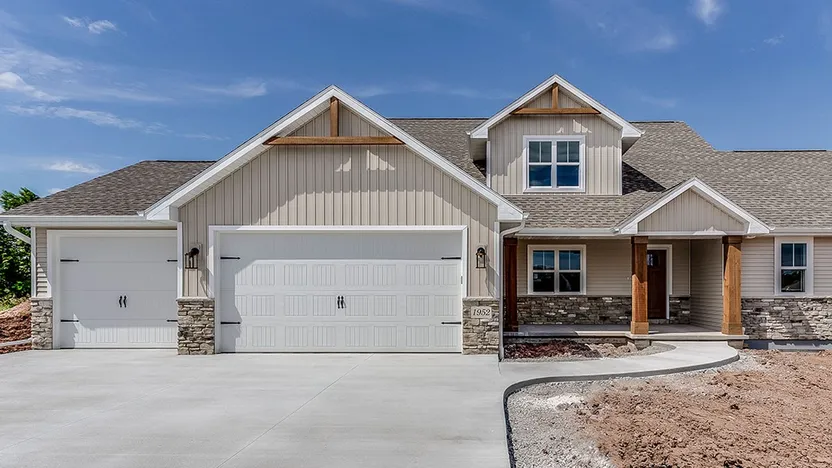Jun 19, 2023

While buying most things in life is a fairly simple process of adding to cart and ponying up a credit card, buying a home is understandably a bit more involved. And if the home you’re hoping to buy is brand new, this type of purchase comes with its own unique process.
Though buying a new-construction home is similar to buying an existing house, there are some key differences. And since new-construction homes constitute about one-third of the U.S. housing inventory today, it’s an option many will want to consider.
For an idea of what to expect, here’s how to buy a new-construction home from beginning to end, plus some advice on keeping the process as smooth as possible.
1. Set a budget
The first step for any prospective homebuyer is to evaluate how much they can afford to spend on a house. This is especially important with new construction, since these homes tend to be a bit pricier upfront (the median new-construction home price currently comes in at $493,000).
“It’s very easy to be enamored and fall in love with a home that may exceed your needs and your budget,” says Don Turner, regional sales director, new homes, at Realtor.com. To avoid this scenario, he says it’s vital to “understand your income versus your spending situation, and set some guidelines.”
To get a ballpark sense of the home price you can afford, you can plug your income, debts, and other information into an online home affordability calculator.
2. Get preapproved for a mortgage
“Getting preapproved is a good idea to determine your buying power and convey that to the builders you’re shopping,” says Jennifer Landers, community manager, Kolter Homes.
There are many ways to get preapproved. You can apply online and learn the loan amount you would qualify for, based on your current income and debt. You can also do this through a builder’s preferred lender—for example, builder Kolter Homes works with CTC Mortgage, which offers an online preapproval tool.
Lenders will ask you to provide financial documentation throughout the lending process, so have bank records and pay stubs ready to go.
Keep in mind, though, that preapproval with a lender does not mean you must move forward with them. In fact, it’s always best to shop around and compare preapproval offers from at least three lenders to make sure you’re getting the best terms and deal.
3. Choose a location
Finding the right community and location for your new-construction home is an important part of the process—not every community will suit every buyer.
For example, if you have a young family, you’re going to be looking for something very different than a homebuyer who is seeking a 55+ neighborhood with HOA activities for retirees.
Landers suggests a “what matters most” ranking exercise, when narrowing down your area search. Decide which of the following are most important, from one to 12, and let the list guide your location decisions:
- Travel/commute times
- Distance to family/friends
- School district quality/higher education
- Access to nature/parks/lakes
- Availability of community clubhouse/social areas
- Walking trails/sidewalks
- Outdoor recreation (e.g., tennis/pickleball courts, playgrounds)
- Neighborhood pool
- Fitness center
- Pet friendliness
- Proximity to shopping/dining/entertainment
- Nearby health care/medical facilities
4. Hire a real estate agent
Though technically you may be able to get a new-construction home without representation, having the right real estate agent can be an invaluable resource to help you find the best fit in a new home and community.
Keep in mind that the on-site agent you meet at a new-construction office works for the builder. So, as the homebuyer, it’s a smart idea to bring in your own agent, as well, to help you negotiate and stay protected in the transaction.
A good buyer’s agent will be able to review any contracts before you sign on the dotted line, ensuring you aren’t unwittingly agreeing to terms that only benefit the builder. And in many cases, the builder will actually pay your agent’s commission as a thank you for bringing your business to them.
Landers recommends that before retaining an agent, you should do your due diligence.
“Check [real estate agent] reviews on third-party sites, ask the agents you’re considering for recommendations on [where they’ve] helped buyers like you purchase over the last six to 12 months,” says Landers.
5. Shop home builders
As when choosing a real estate agent, seek out a homebuilder with a good reputation and check out their reviews online. Also look at the floor plans they offer. You want to make sure they build a floor plan that will suit your family and meet your growing needs—not just today but in the future, too.
Other things to consider? Since finances are usually a deciding factor for new-construction buyers, make sure to compare and contrast what builder incentives are offered.
“Find a builder that is offering buyer incentives, such as special financing deals or assistance with closing costs,” says Turner. “If you can also find a builder that is offering free upgrades in the home—like upgraded cabinets and appliances or maybe better flooring—these are nice wins for the customer.”
Landers suggests also asking some of the following questions:
- What are the HOA dues? Are they monthly or annual? What do they cover as far as amenities, activities, and programs?
- Can guests use the community pool, fitness center, and other amenities?
- What is the community pet policy?
- Do you offer a new home warranty? If so, what does it cover?
- What are the average utility bills and other associated costs of home ownership in the community?
6. Decide whether to build or buy move-in ready
Spec homes are built, or at least started, without a buyer contract in place and can be in various stages of construction. If the home is finished or close to it, it might also be dubbed as “move-in ready” or “quick move-in” (QMI), which is typically ready for occupancy within three months. (That said, each builder will have its own definition of what “quick” is.)
“Build from scratch” means construction starts from the ground up after you commit to the contract. On average, a build-from-scratch house takes about 6.5 months, although that will vary widely by builder, so make sure to ask what their timeline is. Buyers who can wait this long might get the added benefit of having more control over a variety of design decisions, which might include the home’s layout, finishes, and other details.
For clarity, however, homebuyers should understand that there is a big difference between a build-from-scratch home from a production builder in a planned community and a “custom home.” In the latter, you are responsible for everything, including buying the land, getting an architect, securing construction loans, filing for city permits, and so on. A truly custom home could take up to two years to complete. Here’s more on how to build your own home.
7. Sign a builder contract
Predicated on which type of home you choose, the next step will be signing a contract. If you’re getting into a move-in-ready home, chances are the sale will more closely resemble a “normal” real estate transaction of an existing house where you make a down payment, move in, then commence with monthly mortgage payments.
If you’re leaning more toward a build-from-scratch situation, the financing will look a bit different. When you sign a builder contract, there will likely be a deposit required, typically ranging from $1,000 to $2,000. Luckily, Turner says, “most builders use this deposit as a credit toward the purchase price of the home.”
The contract you sign should also include the projected completion timeline. This is also a good opportunity to get clarity about what happens if unforeseen issues arise during building. What happens if supply chain delays impede construction? How will any changes be communicated to you, and what recourse do you have?
At minimum, you should have your real estate agent review your contract. Additionally, it’s smart to also have a lawyer review the agreement and all addendums prior to signing, as an added layer of protection.
8. Prepare to move in
If you’re selling your current home before moving into your new build, make sure you consult your real estate agent about the best time to put your current home on the market. You don’t want to wait too long and end up with a double mortgage. However, if you end up selling before your new-construction home is completed, you might need to find interim housing and put your items into storage for a few months. This adds another layer to the purchase of a new-construction home that must be considered.
Also, buyers should try to not to make any big purchases (such a new furniture or a car) in the interim while their home is being built. This can impact your credit score and jeopardize your mortgage.
9. Have your new home inspected, and do a final walk-through
Just because something is new doesn’t meant it will definitely be perfect. That’s why even though your new-construction home has a home warranty included, it’s still important to have an inspection before you officially take ownership.
New-construction homes are inspected by local municipalities throughout the construction process, and those same groups provide a final certificate of occupancy (CO) before move-in is allowed. When all municipality inspections are complete, your builder will file for a CO, but you might still want to hire your own home inspector just to make sure everything is up to snuff.
You should also be given an opportunity to do a final walk-through of your home before moving in.
“Buyers can then provide a ‘punch list’ of to-do items for the builder to complete,” says Bob Seeman, vice president of sales, new homes, at Realtor.com®. “These are usually small items like paint drips and scuffs on floor tiles.”
10. Close on your mortgage and move in
When your home is finally complete, the builder will likely be anxious to close the deal and get you in there. That is one reason many builders like it when new-construction homebuyers work with their preferred lenders. That way, they can ensure the transfer will go through without delay.
Be prepared to move quickly once given the go-ahead. At that point, you’ll be expected to pony up your full down payment (minus your original deposit) and then pay monthly mortgage payments to your lender going forward.
Source- https://www.realtor.com/advice/buy/steps-to-buy-a-new-construction-home/






